纳米颗粒上的聚(2-甲基-2-恶嗪)壳的拓扑结构决定了它们与血清的相互作用和免疫细胞的摄取。
IF 5.4
2区 化学
Q1 BIOCHEMISTRY & MOLECULAR BIOLOGY
引用次数: 0
摘要
与线性PMOZI (l-PMOZI)相比,环聚(2-甲基-2-恶嗪)(c-PMOZI)刷壳在金纳米颗粒(NPs)上表现出对血清和不同细胞系的增强隐身性能。与化学性质相同的线性壳相比,c-PMOZI壳在选择性募集免疫球蛋白的同时,减少了总体人血清(HS)蛋白的结合,并改变了补体因子3 (C3)的加工。在补体缺乏的胎牛血清(FBS)和表达补体的HS中,聚合物环化显著降低了非吞噬细胞和巨噬细胞对NP的摄取,表明功能调理无效。即使在无血清培养基中,与l- pmozi包被的NPs相比,c- pmozi包被的NPs被巨噬细胞内化的程度降低,这表明更低的不依赖于opsonin的细胞表面亲和力。这项研究表明,环状PMOZI抑制了NPs与蛋白质和细胞的相互作用,突出了对链拓扑的控制如何扩展了聚合物化学工具箱,以调节生理环境中核壳NPs的行为。本文章由计算机程序翻译,如有差异,请以英文原文为准。
The Topology of Poly(2-methyl-2-oxazine) Shells on Nanoparticles Determines Their Interaction with Serum and Uptake by Immune Cells
Cyclic poly(2-methyl-2-oxazine) (c-PMOZI) brush shells on Au nanoparticles (NPs) exhibit enhanced stealth properties toward serum and different cell lines compared to their linear PMOZI (l-PMOZI) counterparts. While selectively recruiting immunoglobulins, c-PMOZI shells reduce overall human serum (HS) protein binding and alter the processing of complement factor 3 (C3) compared to chemically identical linear shells. Polymer cyclization significantly decreases NP uptake by nonphagocytic cells and macrophages in both complement-deficient fetal bovine serum (FBS) and complement-expressing HS, indicating ineffective functional opsonization. Even in serum-free media, c-PMOZI-coated NPs show reduced internalization by macrophages compared to l-PMOZI-coated NPs, suggesting lower opsonin-independent cell surface affinity. This study demonstrates that cyclic PMOZI suppresses interactions of NPs with proteins and cells, highlighting how control over chain topology expands the polymer chemistry toolbox for modulating the behavior of core–shell NPs within physiological environments.
- Download: Download high-res image (238KB)
- Download: Download full-size image
求助全文
通过发布文献求助,成功后即可免费获取论文全文。
去求助
来源期刊

Biomacromolecules
化学-高分子科学
CiteScore
10.60
自引率
4.80%
发文量
417
审稿时长
1.6 months
期刊介绍:
Biomacromolecules is a leading forum for the dissemination of cutting-edge research at the interface of polymer science and biology. Submissions to Biomacromolecules should contain strong elements of innovation in terms of macromolecular design, synthesis and characterization, or in the application of polymer materials to biology and medicine.
Topics covered by Biomacromolecules include, but are not exclusively limited to: sustainable polymers, polymers based on natural and renewable resources, degradable polymers, polymer conjugates, polymeric drugs, polymers in biocatalysis, biomacromolecular assembly, biomimetic polymers, polymer-biomineral hybrids, biomimetic-polymer processing, polymer recycling, bioactive polymer surfaces, original polymer design for biomedical applications such as immunotherapy, drug delivery, gene delivery, antimicrobial applications, diagnostic imaging and biosensing, polymers in tissue engineering and regenerative medicine, polymeric scaffolds and hydrogels for cell culture and delivery.
 求助内容:
求助内容: 应助结果提醒方式:
应助结果提醒方式:


